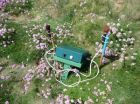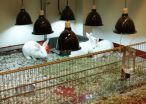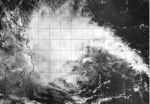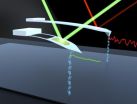(Press-News.org) WASHINGTON, D.C. -- Picture this: A massive asteroid almost as wide as Rhode Island and about three to five times larger than the rock thought to have wiped out the dinosaurs slams into Earth. The collision punches a crater into the planet's crust that's nearly 500 kilometers (about 300 miles) across: greater than the distance from Washington, D.C. to New York City, and up to two and a half times larger in diameter than the hole formed by the dinosaur-killing asteroid. Seismic waves bigger than any recorded earthquakes shake the planet for about half an hour at any one location – about six times longer than the huge earthquake that struck Japan three years ago. The impact also sets off tsunamis many times deeper than the one that followed the Japanese quake.
Although scientists had previously hypothesized enormous ancient impacts, much greater than the one that may have eliminated the dinosaurs 65 million years ago, now a new study reveals the power and scale of a cataclysmic event some 3.26 billion years ago which is thought to have created geological features found in a South African region known as the Barberton greenstone belt. The research has been accepted for publication in Geochemistry, Geophysics, Geosystems, a journal of the American Geophysical Union.
The huge impactor – between 37 and 58 kilometers (23 to 36 miles) wide – collided with the planet at 20 kilometers per second (12 miles per second). The jolt, bigger than a 10.8 magnitude earthquake, propelled seismic waves hundreds of kilometers through the Earth, breaking rocks and setting off other large earthquakes. Tsunamis thousands of meters deep – far bigger than recent tsunamis generated by earthquakes -- swept across the oceans that covered most of the Earth at that time.
"We knew it was big, but we didn't know how big," Donald Lowe, a geologist at Stanford University and a co-author of the study, said of the asteroid.
Lowe, who discovered telltale rock formations in the Barberton greenstone a decade ago, thought their structure smacked of an asteroid impact. The new research models for the first time how big the asteroid was and the effect it had on the planet, including the possible initiation of a more modern plate tectonic system that is seen in the region, according to Lowe.
The study marks the first time scientists have mapped in this way an impact that occurred more than 3 billion years ago, Lowe added, and is likely one of the first times anyone has modeled any impact that occurred during this period of the Earth's evolution.
The impact would have been catastrophic to the surface environment. The smaller, dino-killing asteroid crash is estimated to have released more than a billion times more energy than the bombs that destroyed Hiroshima and Nagasaki. The more ancient hit now coming to light would have released much more energy, experts said.
The sky would have become red hot, the atmosphere would have been filled with dust and the tops of oceans would have boiled, the researchers said. The impact sent vaporized rock into the atmosphere, which encircled the globe and condensed into liquid droplets before solidifying and falling to the surface, according to the researchers.
The impact may have been one of dozens of huge asteroids that scientists think hit the Earth during the tail end of the Late Heavy Bombardment period, a major period of impacts that occurred early in the Earth's history – around 3 billion to 4 billion years ago.
Many of the sites where these asteroids landed were destroyed by erosion, movement of the Earth's crust and other forces as the Earth evolved, but geologists have found a handful of areas in South Africa, and Western Australia that still harbor evidence of these impacts that occurred between 3.23 billion and 3.47 billion years ago. The study's co-authors think the asteroid hit the Earth thousands of kilometers away from the Barberton Greenstone Belt, although they can't pinpoint the exact location.
"We can't go to the impact sites. In order to better understand how big it was and its effect we need studies like this," said Lowe. Scientists must use the geological evidence of these impacts to piece together what happened to the Earth during this time, Lowe said.
The study's findings have important implications for understanding the early Earth and how the planet formed. The impact may have disrupted the Earth's crust and the tectonic regime that characterized the early planet, leading to the start of a more modern plate tectonic system, according to the paper's co-authors.
The pummeling the planet endured was "much larger than any ordinary earthquake," said Norman Sleep, a physicist at Stanford University and co-author of the study. He used physics, models, and knowledge about the formations in the Barberton greenstone belt, other earthquakes and other asteroid impact sites on the Earth and the moon to calculate the strength and duration of the shaking that the asteroid produced. Using this information, Sleep recreated how waves traveled from the impact site to the Barberton greenstone belt and caused the geological formations.
The geological evidence found in the Barberton that the paper investigates indicates that the asteroid was "far larger than anything in the last billion years," said Jay Melosh, a professor at Purdue University in West Lafayette, Indiana, who was not involved in the research.
The Barberton greenstone belt is an area 100 kilometers (62 miles) long and 60 kilometers (37 miles) wide that sits east of Johannesburg near the border with Swaziland. It contains some of the oldest rocks on the planet.
The model provides evidence for the rock formations and crustal fractures that scientists have discovered in the Barberton greenstone belt, said Frank Kyte, a geologist at UCLA who was not involved in the study.
"This is providing significant support for the idea that the impact may have been responsible for this major shift in tectonics," he said.
Reconstructing the asteroid's impact could also help scientists better understand the conditions under which early life on the planet evolved, the paper's authors said. Along with altering the Earth itself, the environmental changes triggered by the impact may have wiped out many microscopic organisms living on the developing planet, allowing other organisms to evolve, they said.
"We are trying to understand the forces that shaped our planet early in its evolution and the environments in which life evolved," Lowe said.
INFORMATION:
The following press release and accompanying graphics can be found at: http://news.agu.org/press-release/scientists-reconstruct-ancient-impact-that-dwarfs-dinosaur-extinction-blast/
Scientists reconstruct ancient impact that dwarfs dinosaur-extinction blast
2014-04-09
ELSE PRESS RELEASES FROM THIS DATE:
Counting the invisible by sound -- a new approach to estimate seabird populations
2014-04-09
AUDIO:
This is a typical one minute recording of an active Cory's Shearwater colony on the island of Corvo in the North Atlantic Ocean, June 2011.
Click here for more information.
Seabirds nest in places that are inaccessible for most humans - vertical cliffs and remote islands surrounded by raging waves. Worse still, many seabirds lay their eggs in burrows or cavities where they are protected from inclement weather and invisible for researchers. Hidden under rocks or in burrows ...
Rabbits kept indoors could be vitamin D deficient
2014-04-09
CHAMPAIGN, Ill. — Rabbits that remain indoors may suffer from a lack of vitamin D, researchers report in a new study. In rabbits kept as pets or used in laboratory studies, the deficiency could lead to dental problems, undermine their cardiovascular health, weaken their immune systems and skew scientific findings.
The study found that regular exposure to artificial ultraviolet B light for two weeks doubled rabbits' serum vitamin D levels – an increase not seen in animals raised in artificial light lacking UVB radiation. Future studies will seek to determine optimal levels ...
Recycling astronaut urine for energy and drinking water
2014-04-09
On the less glamorous side of space exploration, there's the more practical problem of waste — in particular, what to do with astronaut pee. But rather than ejecting it into space, scientists are developing a new technique that can turn this waste burden into a boon by converting it into fuel and much-needed drinking water. Their report, which could also inspire new ways to treat municipal wastewater, appears in the journal ACS Sustainable Chemistry & Engineering.
Eduardo Nicolau, Carlos R. Cabrera and colleagues point out that human waste on long-term journeys into ...
Can animals really help people in hospitals, aged care?
2014-04-09
While many people have an opinion on whether animals can help to improve wellbeing and care for patients in hospitals, does anyone really know whether there are benefits both for the patients and the animals themselves?
Not according to a team of researchers from the University of Adelaide, which has conducted a worldwide review of all studies looking at the impact of "animal interventions" in healthcare settings for children.
The researchers, from the University's School of Psychology and School of Animal and Veterinary Sciences, have found that despite theories emerging ...
NASA satellite sees Tropical Depression Peipah crawling toward Philippines
2014-04-09
NASA-NOAA's Suomi NPP satellite passed over the remnants of Tropical Depression Peipah on April 9 as the storm slowly approached the Philippines from the east. According to the Joint Typhoon Warning Center, Peipah is now not expected to make landfall in eastern Visayas until April 12.
The Visible Infrared Imaging Radiometer Suite or VIIRS instrument aboard Suomi NPP captured a visible, high-resolution image of the storm as it continued moving through the Philippine Sea. The storm appeared disorganized in the image, and the center was difficult to pinpoint on the visible ...
Promising agents burst through 'superbug' defenses to fight antibiotic resistance
2014-04-09
In the fight against "superbugs," scientists have discovered a class of agents that can make some of the most notorious strains vulnerable to the same antibiotics that they once handily shrugged off. The report on the promising agents called metallopolymers appears in the Journal of the American Chemical Society.
Chuanbing Tang and colleagues note that the antibiotic-resistant bacteria known as MRSA (methicillin-resistant Staphylococcus aureus) is responsible for a significant fraction of the infections that patients acquire in hospitals. According to the Centers for ...
Pharma firms turn attention to hearing loss
2014-04-09
Hearing loss affects 36 million Americans to some degree, often leaving them feeling isolated, but it has received little attention from the pharmaceutical industry — until now. Small firms have brought a handful of potential therapies to the development pipeline, and pharmaceutical heavyweights are taking notice, according to an article in Chemical & Engineering News (C&EN), the weekly magazine of the American Chemical Society.
The story states that the most common cause of hearing loss is loud noise, either from a single event like the bang of a firecracker or from ...
Europeans and biomedical research
2014-04-09
This news release is available in French. The French National Institute of Health and Medical Research (Inserm) is currently the leading biomedical research organisation in Europe, and plays a key role in developing European research. To mark its 50th anniversary, Inserm wanted to assess the perceptions of Europeans regarding biomedical research.
To create this European panorama, Ipsos carried out an Internet survey of over 4,000 Europeans (with 1,001 French, 1,004 German, 1,001 Italians and 1,005 British respondents) from 10 to 23 January 2014. Representative samples ...
No compromises: JILA's short, flexible, reusable AFM probe
2014-04-09
JILA researchers have engineered a short, flexible, reusable probe for the atomic force microscope (AFM) that enables state-of-the-art precision and stability in picoscale force measurements. Shorter, softer and more agile than standard and recently enhanced AFM probes, the JILA tips will benefit nanotechnology and studies of folding and stretching in biomolecules such as proteins and DNA.
An AFM probe is a cantilever, shaped like a tiny diving board with a small, atomic-scale point on the free end. To measure forces at the molecular scale in a liquid, the probe attaches ...
Green is good
2014-04-09
As unlikely as it sounds, green tomatoes may hold the answer to bigger, stronger muscles.
Using a screening method that previously identified a compound in apple peel as a muscle-boosting agent, a team of University of Iowa scientists has now discovered that tomatidine, a compound from green tomatoes, is even more potent for building muscle and protecting against muscle atrophy.
Muscle atrophy, or wasting, is caused by aging and a variety of illnesses and injuries, including cancer, heart failure, and orthopedic injuries, to name a few. It makes people weak and fatigued, ...





